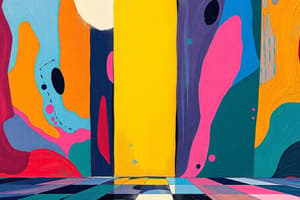Podcast
Questions and Answers
What two terms were added during the 20th century?
What two terms were added during the 20th century?
- Motion (correct)
- Mass
- Shape
- Time (correct)
What are the 8 terms that help to analyze a visual experience?
What are the 8 terms that help to analyze a visual experience?
Line, shape, mass, light, value, color, texture, and space.
What do artists use lines as symbols for?
What do artists use lines as symbols for?
Sound.
What are the primary functions of a line?
What are the primary functions of a line?
What are contour lines used for?
What are contour lines used for?
What is an outline?
What is an outline?
What do our eyes tend to follow in line patterns?
What do our eyes tend to follow in line patterns?
In which painting is linear movement seen?
In which painting is linear movement seen?
What are implied lines?
What are implied lines?
What two categories can shape and mass be divided into?
What two categories can shape and mass be divided into?
What does a three-dimensional form occupy?
What does a three-dimensional form occupy?
What is chiaroscuro?
What is chiaroscuro?
What affects a wide range of psychological and physiological responses?
What affects a wide range of psychological and physiological responses?
What does the term 'hue' refer to?
What does the term 'hue' refer to?
What is the palette used for?
What is the palette used for?
Shapes we perceive as figures are known as ______.
Shapes we perceive as figures are known as ______.
Shapes in the ground are considered ______.
Shapes in the ground are considered ______.
Light reveals the material world to our eyes through ______.
Light reveals the material world to our eyes through ______.
Flashcards are hidden until you start studying
Study Notes
Visual Experience Analysis
- 8 key terms for analyzing visual experiences: line, shape, mass, light, value, color, texture, and space.
- 20th century additions to visual analysis: time and motion.
Lines in Art
- A line is a path traced by a moving point, acting as symbols in writing.
- Artists utilize lines as symbols to convey ideas and emotions.
- Primary functions of a line include defining the borders of form and indicating direction and motion.
- Contour lines define perceived 3-D boundaries; outlines define 2-D shapes.
- Our eyes naturally follow line patterns, which can suggest movement and direction.
Notable Examples
- Thomas Eakins' "Biglin Brothers Racing" uses horizontal and diagonal lines to create visual power.
- "Raft of the Medusa" by Théodore Géricault exemplifies linear movement in painting.
Shapes and Forms
- Shape and mass are categorized into geometric (structured) and organic (natural) types.
- Two-dimensional forms occupy areas with specific boundaries; three-dimensional forms occupy volumes of space.
- Figures are the shapes we focus on, while ground is the surrounding visual information.
Light, Shadow, and Color
- Positive shapes are perceived as figures, and negative shapes are part of the ground.
- Implied shapes unify a composition, while implied light helps perceive spatial relationships.
- Light and shadow model shapes, giving them a 3-D appearance, as seen in Manuel Alvarez Bravo's "The Visit."
- Value refers to shades of light and dark; every color has a value.
Color Theory and Properties
- Chiaroscuro, an Italian term for light and dark, was notably used by da Vinci.
- Color influences psychological and physiological responses; colors have distinct effects (e.g., red stimulates appetite, blue lowers blood pressure).
- Isaac Newton's color theory (1666) explains how light refracts into various colors through prisms.
- Color wheels represent the spectrum of colors: primary (red, yellow, blue), secondary (orange, green, purple), and intermediate colors.
Color Properties
- Key color properties include hue (the name of the color), value (lightness or darkness), and intensity (brightness or dullness).
- A palette is a surface where artists mix pigments; Camille Pissarro exemplified this in "Palette with a Landscape."
Studying That Suits You
Use AI to generate personalized quizzes and flashcards to suit your learning preferences.




